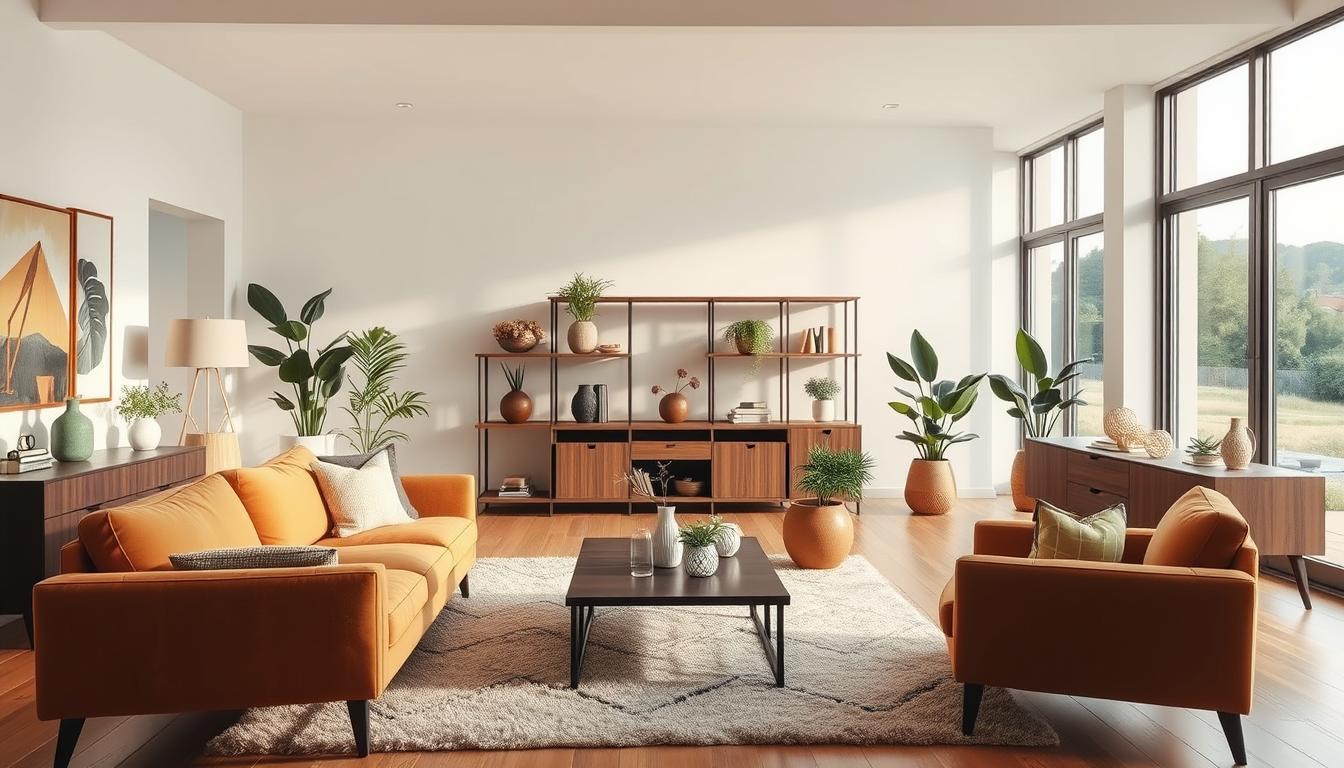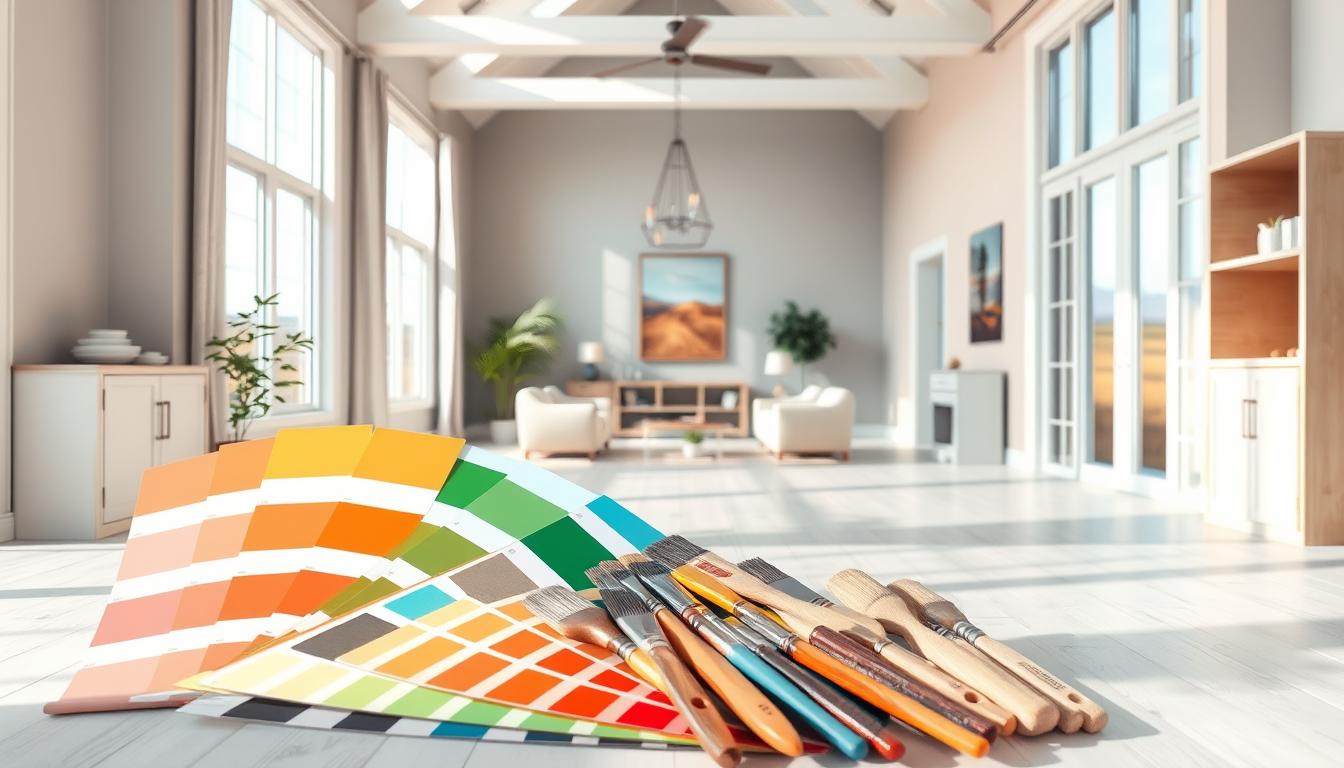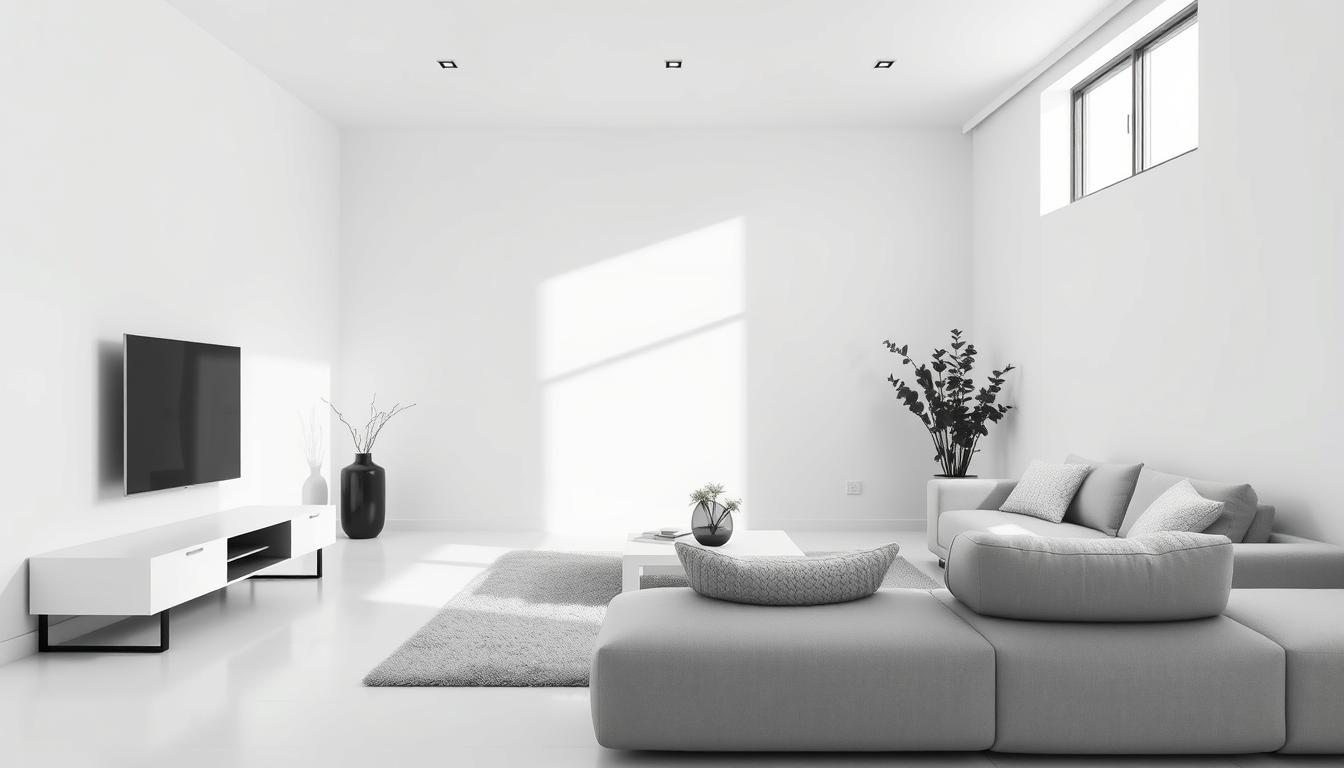Did you know decorating your living space can affect your mood and productivity? With many popular interior design styles out there, picking the right one for your home can be tough.
We enjoy looking into the many design styles that can make a house feel welcoming. Whether it’s modern minimalism or traditional elegance, knowing the different styles helps you create a space that shows who you are and meets your needs.
Key Takeaways
- Discover the top interior design styles that are trending now
- Learn how to incorporate your favorite style into your space
- Understand the significance of choosing the right design style for your home
- Get tips on how to mix and match different styles to create a unique look
- Explore the various elements that define each design style
Understanding Home Interior Design Styles
The world of interior design is vast, with many styles to choose from. Each style has its own unique characteristics. Understanding the basics is key as we dive into home interior design.
What is Interior Design?
Interior design is about making indoor spaces better and more beautiful. It involves knowing about lighting, color, texture, and furniture. Contemporary interior design is simple and functional. Traditional home decor loves classic looks and detailed designs.
The Importance of Style in Home Design
The style of your home’s interior design is crucial. It affects the feel and function of your space. The right style can change your mood, how productive you are, and your overall happiness.
Modern style, for example, is not cold or sterile. It’s about clean lines and less decoration. Traditional styles, on the other hand, bring warmth and coziness with rich textures and classic pieces.
When picking a design style, consider a few things:
- The architectural style of your home
- Your personal preferences and lifestyle
- The natural lighting and spatial layout
- The color palette and textures you wish to incorporate
Understanding these elements helps you create a home that’s beautiful, functional, and comfortable.
Classic Elegance: Traditional Interior Design
The traditional style is a favorite for interior design. It brings a sense of warmth and sophistication. This style has roots in heritage and is timeless.
Key Elements of Traditional Design
Traditional design is known for symmetry, rich colors, and ornate details. Intricate patterns like florals and damasks add depth and interest. These patterns make a room visually appealing.
Classic design often features:
- Classic furniture, like wingback chairs and four-poster beds
- Rich wood tones, such as oak and mahogany
- Ornate accessories, including crystal chandeliers and intricate vases
Color Palettes and Textures
The color palette in traditional design is warm and inviting. It focuses on rich reds, deep blues, and muted golds. These colors are balanced with neutral tones.
Textures are key in traditional design. A mix of smooth and rough surfaces adds depth. Common textures include:
- Velvet and silk fabrics
- Wood and stone surfaces
- Intricately patterned rugs
Suitable Furnishings
Traditional design favors classic, timeless pieces. We look for furniture with clean lines and ornate details. Comfortable proportions are also important.
Popular traditional furnishings include:
- Upholstered sofas and armchairs with intricate patterns
- Wooden furniture, such as dressers and coffee tables, with ornate carvings
- Accent tables with carved legs and marble tops
By using these elements, we can create a traditional interior that is elegant and sophisticated.
Modern Minimalism: Less is More
Minimalism focuses on simplicity and cutting out what’s not needed. In home decor, it means clean lines and fewer decorations. It’s all about what works best, not just looking good.
Core Principles of Minimalist Design
- Simplicity
- Monochromatic color schemes
- Clean lines
- Functionality
Following these rules helps create a peaceful and beautiful space.
Popular Materials Used
Materials are key in minimalist design. Wood, glass, steel, and concrete are top picks.
Benefits of Minimalist Design
Minimalism brings many perks. It cuts down on clutter, helps you focus, makes upkeep simple, and looks great.
Cozy and Inviting: Rustic Decor
Rustic decor brings the outdoors inside, making our homes warm and cozy. It celebrates natural elements, creating a welcoming space.
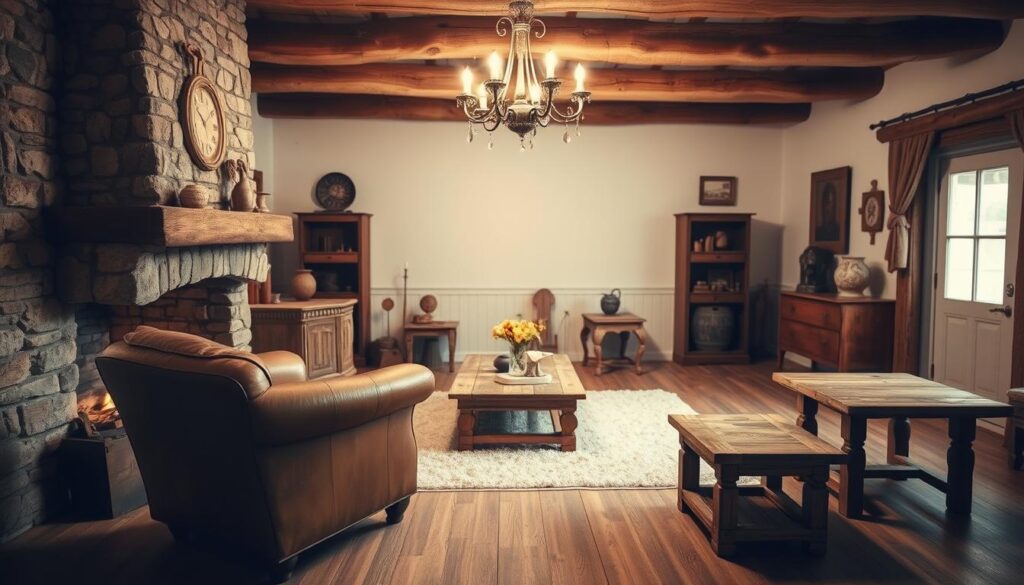
“The rustic style is not just about looks; it’s about comfort and function,” say interior design experts. It uses unpolished stone and natural wood to add warmth and texture.
Defining Characteristics of Rustic Style
The rustic style focuses on organic materials, neutral colors, and practical design. These elements make a space cozy and stylish, blending comfort with style.
- Use of natural materials like wood and stone
- Neutral color schemes that reflect the outdoors
- Functional design that prioritizes comfort and practicality
Material Choices for a Rustic Home
For a rustic home, choose natural materials. Reclaimed wood adds history and character. Stone and brick also create a warm atmosphere.
Popular Rustic Color Schemes
Rustic color schemes often include earthy tones like green, brown, and beige. These colors bring calm and serenity, making a home cozy.
“A rustic color scheme can transform a house into a home, making it feel warm and welcoming.” – Design Expert
Some favorite rustic color schemes are:
| Color Scheme | Description |
|---|---|
| Earth Tones | Features shades of brown, green, and beige |
| Natural Neutrals | Includes colors like cream, taupe, and gray |
| Woodsy Greens | Emphasizes various shades of green, from light to dark |
By using these elements, you can make your home cozy and inviting, capturing the essence of rustic decor.
Bright and Airy: Scandinavian Design
Scandinavian design comes from Nordic culture. It mixes minimalism with coziness. This style is loved for making spaces warm, inviting, and good-looking.
Key Features of Scandinavian Interiors
Scandinavian interiors focus on simplicity, function, and nature. They stand out with:
- Minimalist decor
- Use of natural materials like wood and stone
- Emphasis on functionality
- Neutral color palettes
Design expert Henrik Thor-Larsen said, “Scandinavian design is about more than looks. It’s about making your home feel good.” This is seen in Scandinavian design’s clean lines, simple decor, and focus on being useful.
Importance of Natural Light
Scandinavian design loves natural light. In the Nordic climate, light is key for warmth and welcome. Homes use big windows, few curtains, and shiny surfaces to let in more light.
Benefits of Natural Light:
- Improves mood and well-being
- Reduces the need for artificial lighting
- Creates a sense of spaciousness
Iconic Scandinavian Furniture Brands
Scandinavian design is famous for its smart and stylish furniture. Brands like:
| Brand | Known For |
|---|---|
| Arne Jacobsen | Egg Chair, iconic modernist designs |
| Fritz Hansen | High-quality, modern furniture |
| Muuto | Contemporary, minimalist designs |
Adding Scandinavian design elements, like focusing on natural light and simplicity, makes homes both beautiful and practical.
Bold Statements: Industrial Design
Industrial design is a bold and edgy style that’s become popular lately. It uses raw materials, exposed brick, and metal beams. This style is great for those who want to make a bold statement in their home.
This style is inspired by old factories and warehouses. These places focused on being functional and practical. So, industrial design often includes concrete floors, metal ductwork, and reclaimed wood.
Key Elements of Industrial Design
Several key elements define the industrial design style. These include:
- Exposed ductwork and pipes
- Metal beams and rebar
- Reclaimed wood and brick
- Minimal ornamentation
- Functional decor
Color and Texture in Industrial Design
Industrial design has a muted color palette. It focuses on neutral tones like gray, black, and beige. The texture is often rough and unfinished, with exposed brick, concrete, and metal.
To add warmth, designers use natural materials like wood and plants. This mix of cold, industrial elements and warm natural materials creates a unique and inviting space.
| Item | Description |
|---|---|
| Metal Lighting Fixtures | Exposed bulbs and metal shades add an industrial touch |
| Reclaimed Wood Furniture | Adds warmth and character to a space |
| Exposed Brick | Exposed brick walls are a hallmark of industrial design |
| Industrial Decor | Metal decor items, such as gears and machinery parts, can add an industrial feel to a room |
Vibrant and Creative: Bohemian Interiors
Bohemian interiors are all about creating a space that feels vibrant and creative. They are unique and reflect the owner’s personality. This style combines different elements into a beautiful whole.
Bohemian design uses natural and organic elements. These elements are layered over time, creating a unique look. It’s perfect for those who love to express themselves through their home.
Core Principles
The core of bohemian design is freedom of expression and celebrating individuality. It’s about mixing styles, periods, and textures. This makes a space truly yours.
- Emphasis on natural materials and textures
- Layering of patterns, colors, and decorative items
- Incorporation of vintage or second-hand pieces
- A focus on comfort and personal expression
Mixing Colors and Patterns
Bohemian design is known for its bold color and pattern mixing. We can combine vibrant hues with earthy tones. This creates a rich and layered look.
| Color Palette | Pattern Mix | Texture Combination |
|---|---|---|
| Earthy tones with vibrant accents | Mix of geometric and organic patterns | Combining smooth and rough textures |
| Rich jewel tones with neutral backgrounds | Layering of stripes, florals, and abstracts | Blending of natural fibers with metallic accents |
Iconic Bohemian Accessories
Bohemian interiors feature unique, globally-inspired accessories. Items like vintage rugs and handmade ceramics add depth and character. They make our space special.
By embracing bohemian design, we can create a home that reflects our personality. It tells a story of our travels, interests, and values.
Sophisticated and Luxurious: Art Deco
Art Deco emerged in the 1920s and lasted until the 1940s. It’s known for its luxurious and glamorous look. We’ll look into its unique features, like geometric shapes and metallic materials.
Art Deco design uses bold, bright colors and luxurious materials like velvet and marble. It’s a mix of modern and opulent styles.
Geometric Opulence: Unique Features of Art Deco Design
Art Deco is all about geometric shapes like triangles and circles. These shapes, combined with luxurious materials, create a sense of luxury.
| Characteristics | Description |
|---|---|
| Geometric Shapes | Triangles, circles, and other geometric patterns |
| Luxurious Materials | Marble, velvet, and other luxurious materials |
Popular color combos include black and white, emerald green, and sapphire blue.
Effortless and Serene: Coastal Style
The coastal style brings a calm, seaside vibe into your home. It makes your space feel like a relaxing getaway. This design creates a peaceful and soothing atmosphere.
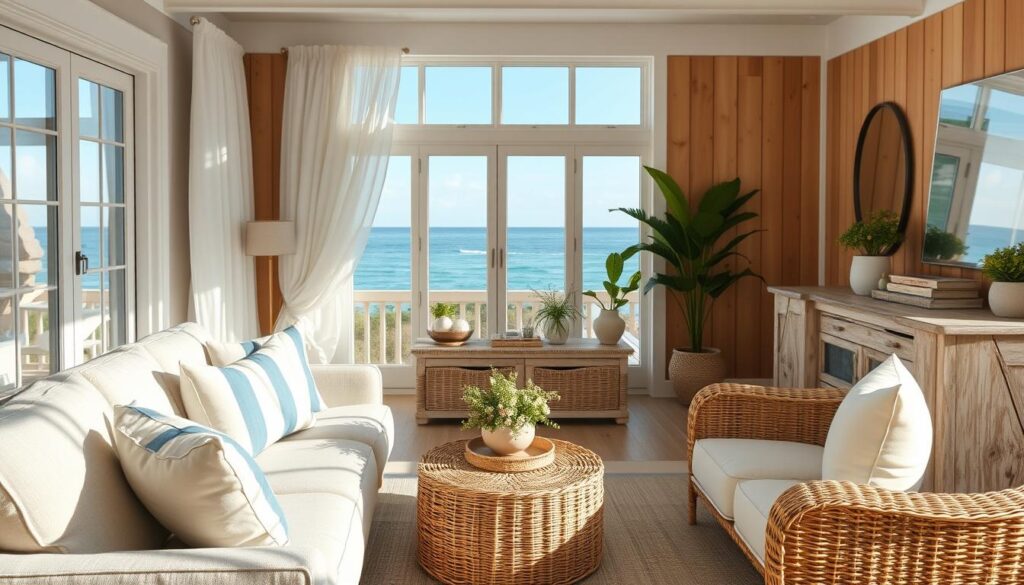
Defining Characteristics
Coastal interiors focus on natural elements and light textures. White-washed woods and light-colored fabrics make spaces feel open and fresh. Natural materials like wicker, jute, and driftwood add warmth and texture.
Suitable Color Palettes
The colors in coastal style are calming and soothing. Blues, from sky tones to navy, pair well with whites and sandy neutrals. These colors remind us of the sea, sand, and sky, making the atmosphere serene.
- Soft blues and whites
- Sandy neutrals and beige
- Seafoam greens and aqua
Key Decor Elements
To get a coastal vibe, add beach and ocean-inspired elements. Nautical decor like anchors and shells brings the seaside in. Using natural textiles like linen and cotton also adds to the coastal feel.
Some favorite decor items include:
- Shells and starfish
- Driftwood and reclaimed wood pieces
- Nautical-themed accessories
With these elements, you can make your home feel both calm and serene. It’s perfect for relaxing and unwinding.
Fusion of Styles: Eclectic Design
Eclectic home design celebrates individuality and self-expression. It lets us mix styles to create a space that shows who we are.
Creating Harmony
To make an eclectic space work, we need to balance different elements. We can do this by combining bold colors and patterns. Mixing textures like fur, velvet, and leather also helps.
Adding global accents like Moroccan rugs or Chinese vases brings cultural richness. Vintage pieces can also add a timeless feel to our space.
Tips for Eclectic Decor
To start an eclectic home, build a neutral base. Then, add statement pieces. Don’t hesitate to mix and match styles and textures for a unique look.
By embracing eclectic design, we can make our home truly our own. With creativity, our home can reflect our personality and style.

